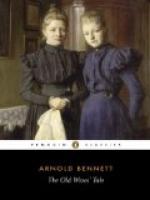Constance, trembling, took pains to finish undressing with dignified deliberation. Sophia’s behaviour under the blow seemed too good to be true; but it gave her courage. At length she turned out the gas and lay down by Sophia. And there was a little shuffling, and then stillness for a while.
“And if you want to know,” said Constance in a tone that mingled amicableness with righteousness, “mother’s decided with Aunt Harriet that we are both to leave school next term.”
CHAPTER III
A BATTLE
I
The day sanctioned by custom in the Five Towns for the making of pastry is Saturday. But Mrs. Baines made her pastry on Friday, because Saturday afternoon was, of course, a busy time in the shop. It is true that Mrs. Baines made her pastry in the morning, and that Saturday morning in the shop was scarcely different from any other morning. Nevertheless, Mrs. Baines made her pastry on Friday morning instead of Saturday morning because Saturday afternoon was a busy time in the shop. She was thus free to do her marketing without breath-taking flurry on Saturday morning.
On the morning after Sophia’s first essay in dentistry, therefore, Mrs. Baines was making her pastry in the underground kitchen. This kitchen, Maggie’s cavern-home, had the mystery of a church, and on dark days it had the mystery of a crypt. The stone steps leading down to it from the level of earth were quite unlighted. You felt for them with the feet of faith, and when you arrived in the kitchen, the kitchen, by contrast, seemed luminous and gay; the architect may have considered and intended this effect of the staircase. The kitchen saw day through a wide, shallow window whose top touched the ceiling and whose bottom had been out of the girls’ reach until long after they had begun to go to school. Its panes were small, and about half of them were of the “knot” kind, through which no object could be distinguished; the other half were of a later date, and stood for the march of civilization. The view from the window consisted of the vast plate-glass windows of the newly built Sun vaults, and of passing legs and skirts. A strong wire grating prevented any excess of illumination, and also protected the glass from the caprices of wayfarers in King Street. Boys had a habit of stopping to kick with their full strength at the grating.




